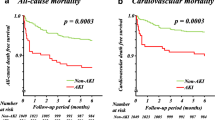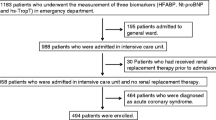Abstract
Progression to acute kidney injury (AKI) under treatment in adult congenital heart disease (ACHD) patients with heart failure is associated with poor prognosis, early detection and interventions are necessary. We aimed to explore the utility of urinary liver-type fatty acid binding protein (L-FABP) in ACHD patients hospitalized for acute decompensated heart failure (ADHF). We prospectively evaluated hemodynamic, biochemical data, and urinary biomarkers including urinary L-FABP in ACHD patients hospitalized in our institution from June 2019 to March 2022. The primary outcomes were the development of AKI and death. AKI was defined as serum creatinine level increased by 0.3 mg/dl or more within 5 days after hospitalization. A total of 104 ADHF patients aged 31 (36–51) years were enrolled. 26 cases (25% of ADHF patients) developed AKI during hospitalization and 4 died after hospital discharge. Serum creatinine (sCr), serum total bilirubin, brain natriuretic peptide (BNP), and urinary L-FABP in AKI patients were significantly higher than in non-AKI patients, whereas systemic oxygen saturation of the peripheral artery (SpO2) and estimated glomerular filtration ratio in AKI patients were lower than non-AKI patients. There was no difference in the intravenous diuretic dose on admission and during hospitalization between the two groups. In the receiver operating characteristic (ROC) analysis, the maximum area under the curve (AUC) of urinary biomarkers in AKI patients was urinary L-FABP (AUC = 0.769, p < 0.001) with a cutoff value of 4.86 µg/gCr. Urinary L-FABP level on admission was associated with a predictor for AKI development during hospitalization after adjusting for sCr, BNP and SpO2. Urinary L-FABP was a useful predictor for the development of AKI in ACHD patients hospitalized for ADHF. Monitoring of urinary L-FABP allows us to detect a high-risk patient earlier than the conventional biomarkers.


Similar content being viewed by others
References
Okura Y, Ramadan MM, Ohno Y, Mitsuma W, Tanaka K, Ito M, Suzuki K, Tanabe N, Kodama M, Aizawa Y (2008) Impending epidemic: future projection of heart failure in Japan to the year 2055. Circ J 72:489–491
Andreucci M, Faga T, Pisani A, Perticone M, Michael A (2017) The ischemic /nephrotoxic acute kidney injury and the use of renal biomarkers in clinical practice. Eur J Intern Med 39:1–8
Smith GL, Vaccarino V, Kosiborod M, Lichtman JH, Cheng S, Watnick SG, Krumholz HM (2003) Worsening renal function: what is a clinically meaningful change in creatinine during hospitalization with heart failure? J Card Fail 9:13–25
Amin AP, Spertus JA, Reid KJ, Lan X, Buchanan DM, Decker C, Masoudi FA (2010) The prognostic importance of worsening renal function during an acute myocardial infarction on long-term mortality. Am Heart J 160:1065–1071
Damman K, Valente MAE, Voors AA, O’connor CM, Van Veldhuisen DJ, Hillege HL (2014) Renal impairment, worsening renal function, and outcome in patients with heart failure: an updated meta-analysis. Eur Heart J 35:455–469
Star RA (1998) Treatment of acute renal failure. Kidney Int 54:1817–1831
Charlton JR, Portilla D, Okusa MD (2014) A basic science view of acute kidney injury biomarkers. Nephrol Dial Transplant 29:1301–1311
Alge JL, Arthur JM (2015) Biomarkers of AKI: a review of mechanistic relevance and potential therapeutic implications. Clin J Am Soc Nephrol 10:147–155
Okubo Y, Sairaku A, Morishima N, Ogi H, Matsumoto T, Kinoshita H, Kihara Y (2018) Increased urinary liver-type fatty acid-binding protein level predicts worsening renal function in patients with acute heart failure. J Card Fail 24:520–524
Hishikari K, Hikita H, Nakamura S, Nakagama S, Mizusawa M, Yamamoto T, Doi J, Hayashi Y, Utsugi Y, Araki M, Sudo Y, Kimura S, Takahashi A, Ashikaga T, Isobe M (2017) Urinary liver-type fatty acid-binding protein level as a predictive biomarker of acute kidney injury in patients with acute decompensated heart failure. Cardiorenal Med 7:267–275
Yamamoto T, Noiri E, Ono Y, Doi K, Negishi K, Kamijo A, Kimura K, Fujita T, Kinukawa T, Taniguchi H, Nakamura K, Goto M, Shinozaki N, Ohshima S, Sugaya T (2007) Renal L-type fatty acid binding protein in acute ischemic injury. J Am Soc Nephrol 18:2894–2902
Matsumori R, Shimada K, Kiyanagi T, Hiki M, Fukao K, Hirose K, Ohsaki H, Miyazaki T, Kume A, Yamada A, Takagi A, Ohmura H, Miyauchi K, Daida H (2012) Clinical significance of the measurements of urinary liver-type fatty acid binding protein levels in patients with acute coronary syndrome. J Cardiol 60:168–173
Nielsen SE, Sugaya T, Hovind P, Baba T, Parving HH, Rossing P (2010) Urinary liver-type fatty acid-binding protein predicts progression to nephropathy in type 1 diabetic patients. Diabetes Care 33:1320–1324
Kamijo-Ikemori A, Sugaya T, Yasuda T, Kawata T, Ota A, Tatsunami S, Kaise R, Ishimitsu T, Tanaka Y, Kimura K (2011) Clinical significance of urinary liver-type fatty acid-binding protein in diabetic nephropathy of type 2 diabetic patients. Diabetes Care 34:691–696
Manabe K, Kamihata H, Motohiro M, Senoo T, Yoshida S, Iwasaka T (2012) Urinary liver-type fatty acid-binding protein level as a predictive biomarker of contrast-induced acute kidney injury. Eur J Clin Invest 42:557–563
McKee PA, Castelli WP, McNamara PM, Kannel WB (1971) The natural history of congestive heart failure: the Framingham study. N Engl J Med 285:1441–1446
Soyler C, Tanriover MD, Ascioglu S, Aksu NM, Arici M (2015) Urine neutrophil gelatinase-associated lipocalin levels predict acute kidney injury in acute decompensated heart failure patients. Ren Fail 37:772–776
Torregrosa I, Montoliu C, Urios A, Andrés-Costa MJ, Giménez-Garzó C, Juan I, Puchades MJ, Blasco ML, Carratalá A, Sanjuán R, Miguel A (2015) Urinary KIM-1, NGAL and L-FABP for the diagnosis of AKI in patients with acute coronary syndrome or heart failure undergoing coronary angiography. Heart Vessels 30:703–711
Greenberg JH, Zappitelli M, Jia Y, Thiessen-Philbrook HR, De Fontnouvelle CA, Wilson FP, Coca S, Devarajan P, Parikh CR (2018) Biomarkers of AKI progression after pediatric cardiac surgery. J Am Soc Nephrol 29:1549–1556
Matthys E, Patel Y, Kreisberg J, Stewart JH, Venkatachalam M (1984) Lipid alterations induced by renal ischemia: pathogenic factor in membrane damage. Kidney Int 26:153–161
Sasaki H, Kamijo-Ikemori A, Sugaya T, Yamashita K, Yokoyama T, Koike J, Sato T, Yasuda T, Kimura K (2009) Urinary fatty acids and liver-type fatty acid binding protein in diabetic nephropathy. Nephron Clin Pract 112:c148-156
Damman K, Ng Kam Chuen MJ, MacFadyen RJ, Lip GY, Gaze D, Collinson PO, Hillege HL, van Oeveren W, Voors AA, van Veldhuisen DJ (2011) Volume status and diuretic therapy in systolic heart failure and the detection of early abnormalities in renal and tubular function. J Am Coll Cardiol 57:2233–2241
Opotowsky AR, Carazo M, Singh MN, Dimopoulos K, Cardona-Estrada DA, Elantably A, Waikar SS, Mc Causland FR, Veldtman G, Grewal J, Gray C, Loukas BN, Rajpal S (2019) Creatinine versus cystatin C to estimate glomerular filtration rate in adults with congenital heart disease: results of the Boston Adult Congenital Heart Disease Biobank. Am Heart J 214:142–155
Sharma S, Ruebner RL, Furth SL, Dodds KM, Rychik J, Goldberg DJ (2016) Assessment of kidney function in survivors following fontan palliation. Congenit Heart Dis 11:630–636
Yana A, Masutani S, Kojima T, Saiki H, Taketazu M, Tamura M, Senzaki H (2013) Usefulness of cystatin C in the postoperative management of pediatric patients with congenital heart disease. Circ J 77:667–672
Opotowsky AR, Baraona FR, Mc Causland FR, Loukas B, Landzberg E, Landzberg MJ, Sabbisetti V, Waikar SS (2017) Estimated glomerular filtration rate and urine biomarkers in patients with single-ventricle Fontan circulation. Heart 103:434–442
Yoneyama F, Okamura T, Takigiku K, Yasukouchi S (2020) Novel urinary biomarkers for acute kidney injury and prediction of clinical outcomes after pediatric cardiac surgery. Pediatr Cardiol 41:695–702
Cooper DS, Claes D, Goldstein SL, Bennett MR, Ma Q, Devarajan P, Krawczeski CD (2016) Follow-up renal assessment of injury long-term after acute kidney injury (FRAIL-AKI). Clin J Am Soc Nephrol 11:21–29
Toda Y, Sugimoto K (2017) AKI after pediatric cardiac surgery for congenital heart diseases-recent developments in diagnostic criteria and early diagnosis by biomarkers. J Intensive Care 5:49
Dimopoulos K, Diller GP, Koltsida E, Pijuan-Domenech A, Papadopoulou SA, Babu-Narayan SV, Salukhe TV, Piepoli MF, Poole-Wilson PA, Best N, Francis DP, Gatzoulis MA (2008) Prevalence, predictors, and prognostic value of renal dysfunction in adults with congenital heart disease. Circulation 117:2320–2328
Matsui K, Kamijo-Ikemori A, Imai N, Sugaya T, Yasuda T, Tatsunami S, Toyama T, Shimizu M, Furuichi K, Wada T, Shibagaki Y, Kimura K (2016) Clinical significance of urinary liver-type fatty acid-binding protein as a predictor of ESRD and CVD in patients with CKD. Clin Exp Nephrol 20:195–203
Matsui K, Kamijo-Ikemori A, Sugaya T, Yasuda T, Kimura K (2012) Usefulness of urinary biomarkers in early detection of acute kidney injury after cardiac surgery in adults. Circ J 76:213–220
Aghel A, Shrestha K, Mullens W, Borowski A, Tang WHW (2010) Serum neutrophil gelatinase-associated lipocalin (NGAL) in predicting worsening renal function in acute decompensated heart failure. J Card Fail 16:49–54
Acknowledgements
We are grateful to all the patients and medical staffs involved in our clinical practice.
Funding
This research received no grant from any funding agency in the public, commercial or not-for-profit sectors.
Author information
Authors and Affiliations
Corresponding author
Ethics declarations
Conflict of interests
The authors have no conflicts of interest to declare.
Additional information
Publisher's Note
Springer Nature remains neutral with regard to jurisdictional claims in published maps and institutional affiliations.
Rights and permissions
Springer Nature or its licensor holds exclusive rights to this article under a publishing agreement with the author(s) or other rightsholder(s); author self-archiving of the accepted manuscript version of this article is solely governed by the terms of such publishing agreement and applicable law.
About this article
Cite this article
Wakisaka, Y., Inai, K., Sato, M. et al. Utility of urinary liver-type fatty acid-binding protein as a prognostic marker in adult congenital heart patients hospitalized for acute heart failure. Heart Vessels 38, 371–380 (2023). https://doi.org/10.1007/s00380-022-02174-0
Received:
Accepted:
Published:
Issue Date:
DOI: https://doi.org/10.1007/s00380-022-02174-0




